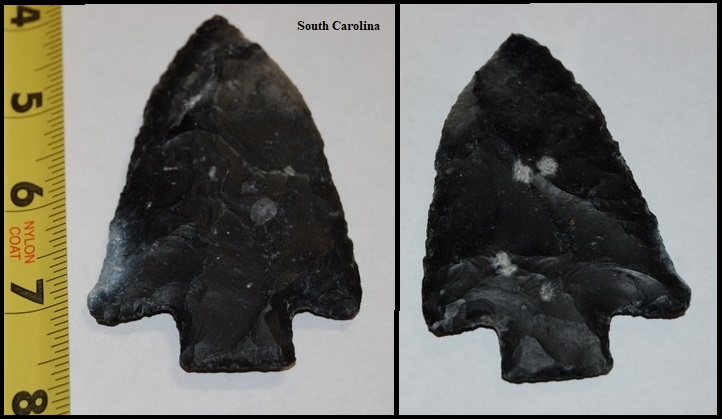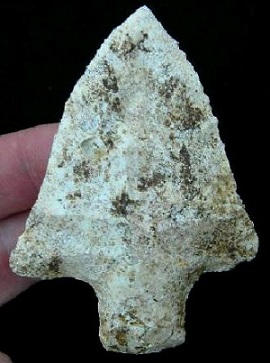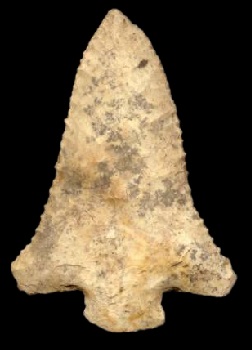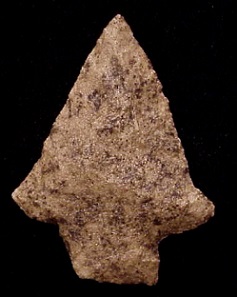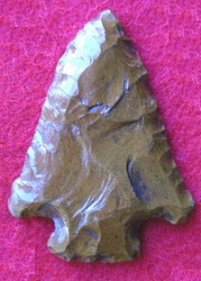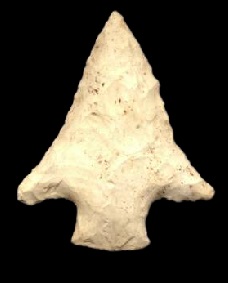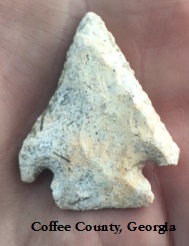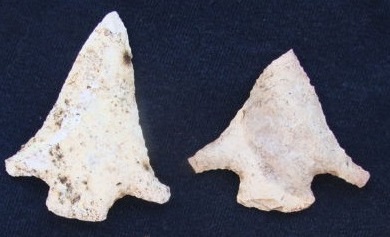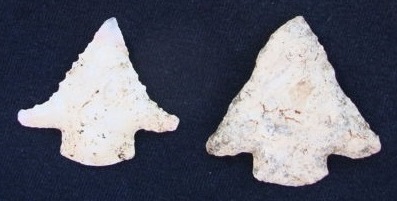Outline is Representative of Size and Shape:

Name Details:
Identified By: David Hulse and Ralph Allen
Named For: Abbie (Abbey) Creek, Henry County, Alabama
Date Identified: 1964
Type Site: Multiple sites in around Abbie Creek, Henry County, Alabama.
Identified By: David Hulse and Ralph Allen
Named For: Abbie (Abbey) Creek, Henry County, Alabama
Date Identified: 1964
Type Site: Multiple sites in around Abbie Creek, Henry County, Alabama.
Point Validity: Valid type
Hulse was credited for naming this type, but it is believed that Ralph Allen was the person who fist identified this type and named it. Allen supplied examples from Abbey Creek to David Hulse who published the type. Allen conducted extensive archaeological studies around Alabama. Hulse is a renowned avocational archaeologist. This point has been referred to in numerous professional publications and is considered a valid type
Abbie Stemmed
AKA: AbbieCluster:
Description of Physical Characteristics and Flaking Pattern:
This is a broad medium (1.5 to 2.75 inches) triangular stemmed point with a flattened or hexagonal cross section. Infrequently the point may have an elliptical cross section. The blade varies from straight to incurvate or recurvate, curving in at the tip and flaring out at the shoulder. The blade is commonly re-worked leaving steep bevels on all edges and fine serrations. The shoulders are commonly asymmetrical and may range from slightly barbed to having a slightly upward angle. The stem ranges from straight to slightly expanding. The base varies from straight to slightly convex and is commonly thinned. This point has a random flaking pattern.
Size Measurements:
Length - 38 to 80 mm (average 42 to 52 mm), Stem Length - 8 to 14 mm (average 10 to 11 mm), Blade Width - 32 to 61 mm (40 to 50 mm average), Stem Width - 12 to 23 mm (17 to 20 mm average), Thickness - 7 to 12 mm
Length - 38 to 80 mm (average 42 to 52 mm), Stem Length - 8 to 14 mm (average 10 to 11 mm), Blade Width - 32 to 61 mm (40 to 50 mm average), Stem Width - 12 to 23 mm (17 to 20 mm average), Thickness - 7 to 12 mm
Commonly Utilized Material:
Additional Comments:
The Abbey point has characteristics from both the Benton and Pickwick cluster.
The Abby point is commonly found in a completely spent or heavily re-sharpened condition. Gregory Perino has argued that the Abby point may represent an exhausted Maples point which has a short blade due to extensive re-sharpening (W11).
The Cottonbridge type may represent a variant of the Abbey type. The Cottonbridge type has the same distribution and has many of the same characteristics. The Cottonbridge type may be distinguished from the Abbey type by the straight to excurvate blade and the convex to rounded basal edge while the Abbey type commonly has a recurvate blade and a straight basal edge (Granger and Granger, 2013).
Ralph Allen submitted many examples of this type to David Hulse who published the information referring this point. The examples provided by Allen were from Abbie Creek in Alabama. Hulse misspelled the name of the creek naming this point the Abbey point. There has been some who suggest to use the name Abbie after the creek, but currently the name still remains Abbey.
The Abbey point has characteristics from both the Benton and Pickwick cluster.
The Abby point is commonly found in a completely spent or heavily re-sharpened condition. Gregory Perino has argued that the Abby point may represent an exhausted Maples point which has a short blade due to extensive re-sharpening (W11).
The Cottonbridge type may represent a variant of the Abbey type. The Cottonbridge type has the same distribution and has many of the same characteristics. The Cottonbridge type may be distinguished from the Abbey type by the straight to excurvate blade and the convex to rounded basal edge while the Abbey type commonly has a recurvate blade and a straight basal edge (Granger and Granger, 2013).
Ralph Allen submitted many examples of this type to David Hulse who published the information referring this point. The examples provided by Allen were from Abbie Creek in Alabama. Hulse misspelled the name of the creek naming this point the Abbey point. There has been some who suggest to use the name Abbie after the creek, but currently the name still remains Abbey.
Distribution: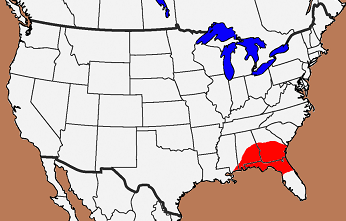

Distribution Comments:
This point is primarily found in the coastal plains of Georgia, Alabama, and the panhandle of Florida. Reported into central Georgia and Alabama with decreased frequency.
This point is primarily found in the coastal plains of Georgia, Alabama, and the panhandle of Florida. Reported into central Georgia and Alabama with decreased frequency.
Age / Periods:
Date: 5,000 - 4,000 B.P.
Cultural Period: Middle Archaic
Glacial Period: Middle Holocene
Culture:
Date: 5,000 - 4,000 B.P.
Cultural Period: Middle Archaic
Glacial Period: Middle Holocene
Culture:
Age Details:
Webb (1998) suggest an age of 4,500 to 4,990 B.P. based on radiocarbon dating from site 9DW70, Dawson County, Georgia
Webb (1998) suggest an age of 4,500 to 4,990 B.P. based on radiocarbon dating from site 9DW70, Dawson County, Georgia
Similar Points:
Alachua, Benton, Cottonbridge, Elora, Levy, Maples, Notchaway, Pickwick, Savannah River, Six Mile Creek, South Prong Creek, Wacissa
Alachua, Benton, Cottonbridge, Elora, Levy, Maples, Notchaway, Pickwick, Savannah River, Six Mile Creek, South Prong Creek, Wacissa

